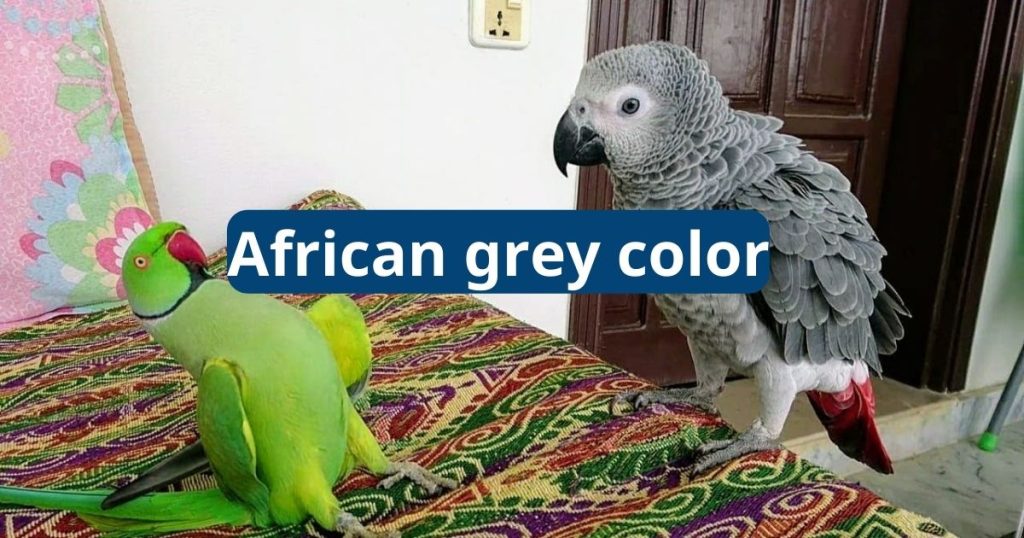African Grey Color

Due to their intelligence (anecdotes indicate they have the intellectual capacity of a 5-year-old child), sociability and amazing mimicry, African greys are highly sought after companion birds. Sadly, the wild population is under threat by illegal trapping and trade. These large parrots are found in forests across west Africa and into Cameroon. They are also gregarious and can be seen roosting in large colonies.
Characteristics
African Grey parrots are renowned for their intelligence, sociability and ability to imitate human speech. They are able to recognize colors, shapes and numbers. In addition, they can understand and follow simple commands.
Parrots begin searching for a mate at three to five years old and will often find pre-existing tree cavities in which to lay their eggs. Both African Grey parents will incubate the eggs and care for their chicks after they hatch.
The African Grey is a talkative bird that can learn to pronounce words by the age of 12. They will also start mimicking sounds and chattering throughout the day. They will usually screech to get attention or if they are hungry, bored or upset.
African Greys are good breeders, laying 2-4 eggs at a time with an incubation period of 21-30 days. They enjoy a variety of foods including fruits, leafy vegetables, seeds, nuts and palm nuts. They prefer to chew their food rather than swallow it whole. They do not enjoy intense physical affection, though they will tolerate light head scratches and petting.

Breeding
African Greys are one of the most intelligent parrot species bred in captivity. They can imitate words, songs, verses, whistles, coughs and even some electronic sounds like ringing telephones. They can also identify their owners through facial expressions and body language. In general, they are very talkative birds that love to chatter throughout the day.
They are very social creatures and need plenty of interaction and training to thrive. If they do not receive enough attention, they may become depressed and display self-mutilating behaviors such as feather picking.
A male African Grey will have a solid red tail, while a female’s tail feathers are more of a silver color. Hens have a gradual dark to light transition of gray from the neck down. In addition, a male’s undertail covert feathers will be darker and have a dark color on the topside, while hens’ undertail coverts are lighter and have a silver color on the topside.

Care
African greys are intelligent, affectionate birds that bond well with their families. They can live up to 30 years in captivity. They need regular physical exams and preventative veterinary care, including nail and beak trimming. This can help your vet identify and prevent health problems such as bumblefoot, feather picking, and vitamin deficiency.
During adolescence male and female African greys become identifiable by the red color of their tail feathers. A bright red tail indicates a healthy bird and is a good way to distinguish them from other flock members.
Hand-raised African greys are easier to tame and train than wild or colony-bred birds. However, all new pets should be gradually introduced to people, animals, and new situations to help them cope with stress and anxiety.

Feeding
African greys are a highly intelligent, social species that can mimic and interpret the sounds of household appliances, voices, doorbells, dripping water, yelling and even swear words. They can also distinguish between male and female voices. They can whistle, squeak and shriek to communicate with their owners. These intelligent birds can even recall past conversations and interactions. They can live 50-70 years in captivity, but may become withdrawn and lash out at those that do not treat them well.
In the wild, african greys feed on a wide variety of seeds and nuts as well as fruits, vegetables and leafy greens. Commercial seed mixes, which are commonly fed to captive parrots, can be deficient in many nutrients and limit their health.
Regular, preventative veterinary checkups will help spot problems and address them quickly. These semi-annual appointments should include a physical examination, grooming (nail and feather trimming as needed), laboratory tests, and dietary review. New birds should be introduced to young and old people, males and females, other pets and family members early on to promote healthy adjustment.



